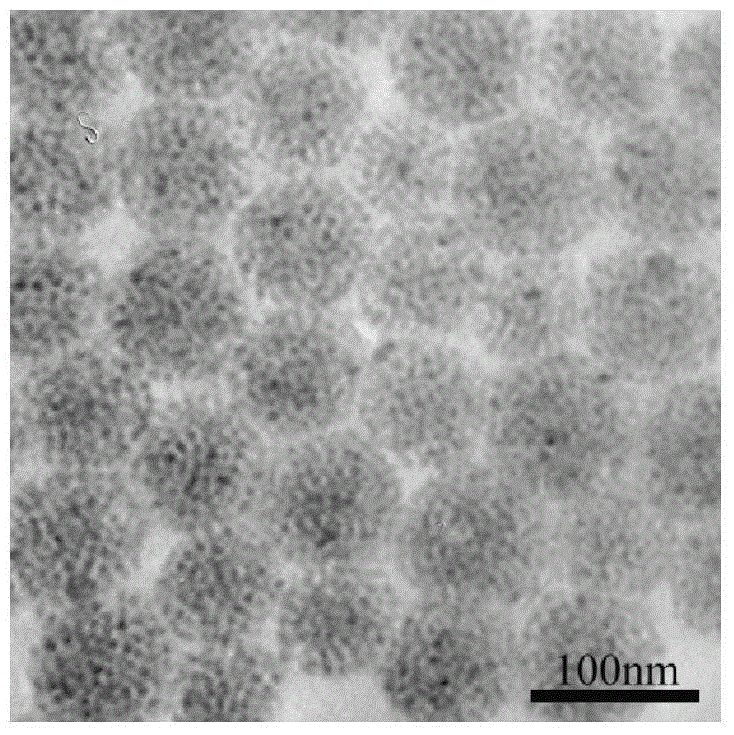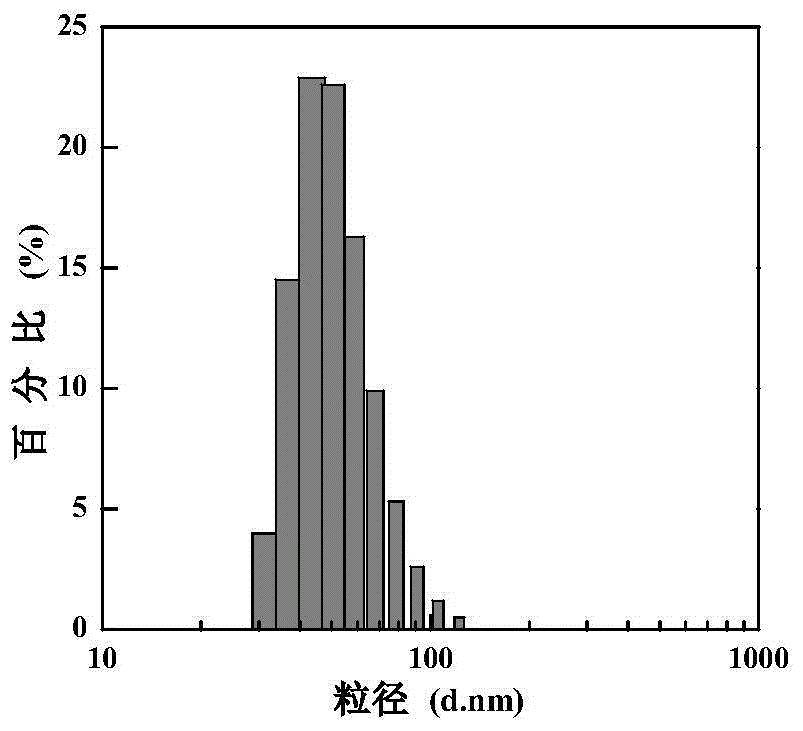Preparation of hydrophilic fluorescent nanospheres by a photopolymerization method and its application in the detection of 2,4,6-trinitrotoluene explosives
A fluorescent nanometer and hydrophilic technology, applied in the field of nitro-explosives sensing and detection, can solve the problems of low sensitivity, difficult to operate equipment, complicated instruments, etc., and achieve the effect of small background interference, uniform size and simple operation.
- Summary
- Abstract
- Description
- Claims
- Application Information
AI Technical Summary
Problems solved by technology
Method used
Image
Examples
Embodiment 1
[0026] 1. 0.8mmol of zinc sulfide doped with manganese quantum dots (the molar doping amount of manganese is 5%) and 0.06mmol of 0.06mmol of chloroform are injected into 6mL of chloroform, stirred evenly for 20min, and the product is used Precipitate with 20mL of ethanol, centrifuge to obtain a white precipitate, and then ultrasonically disperse it in 4mL of chloroform to obtain an allyl thiol-modified zinc sulfide-doped manganese quantum dot dispersion;
[0027] 2. Add 18mg sodium dodecylsulfonate into 10mL deionized water to completely dissolve;
[0028] 3. Mix 0.25mL of the dispersion obtained in step 1, 6.25μg of azobisisobutyronitrile, and 0.75mL of chloroform evenly, pour it into the aqueous solution of sodium dodecylsulfonate prepared in step 2, and place it in an ultrasonic cell disruptor Ultrasound for 3 minutes to obtain a white microemulsion;
[0029] 4. Place the white microemulsion obtained in step 3 under a 365nm ultraviolet laser and irradiate it for 10 minutes...
Embodiment 2
[0032] 1. 0.5mmol of zinc sulfide doped with manganese quantum dots (the molar doping amount of manganese is 5%) and 0.06mmol of 0.06mmol of chloroform are injected into 6mL of chloroform, stirred evenly for 20min, and the product is used Precipitate with 20mL of ethanol, centrifuge to obtain a white precipitate, and then ultrasonically disperse it in 4mL of chloroform to obtain an allyl thiol-modified zinc sulfide-doped manganese quantum dot dispersion;
[0033] 2. Add 18mg sodium dodecylsulfonate into 10mL deionized water to completely dissolve;
[0034] 3. Mix 0.40 mL of the dispersion obtained in step 1, 10.0 μg of azobisisobutyronitrile, and 0.60 mL of chloroform evenly, pour it into the aqueous solution of sodium dodecylsulfonate prepared in step 2, and place it in an ultrasonic cell disruptor Ultrasound for 3 minutes to obtain a white microemulsion;
[0035] 4. Place the white microemulsion obtained in step 3 under a 365nm ultraviolet laser and irradiate it for 10 minu...
Embodiment 3
[0038]1. Inject 0.3mmol of zinc sulfide-doped manganese quantum dots in the oil phase (the molar doping amount of manganese is 5%), and 0.06mmol of allyl mercaptan are injected into 6mL of chloroform, stirred evenly for 20min, and the product is precipitated with 20mL of ethanol, Centrifuge to obtain a white precipitate, and then ultrasonically disperse it in 4mL of chloroform to obtain an allyl thiol-modified zinc sulfide-doped manganese quantum dot dispersion;
[0039] 2. Add 18mg sodium dodecylsulfonate into 10mL deionized water to completely dissolve;
[0040] 3. Mix 0.66 mL of the dispersion obtained in step 1, 16.5 μg of azobisisobutyronitrile, and 0.34 mL of chloroform evenly, pour it into the aqueous solution of sodium dodecylsulfonate prepared in step 2, and place it in an ultrasonic cell disruptor Ultrasound for 3 minutes to obtain a white microemulsion;
[0041] 4. Place the white microemulsion obtained in step 3 under a 365nm ultraviolet laser and irradiate it for...
PUM
| Property | Measurement | Unit |
|---|---|---|
| wavelength | aaaaa | aaaaa |
Abstract
Description
Claims
Application Information
 Login to View More
Login to View More - R&D
- Intellectual Property
- Life Sciences
- Materials
- Tech Scout
- Unparalleled Data Quality
- Higher Quality Content
- 60% Fewer Hallucinations
Browse by: Latest US Patents, China's latest patents, Technical Efficacy Thesaurus, Application Domain, Technology Topic, Popular Technical Reports.
© 2025 PatSnap. All rights reserved.Legal|Privacy policy|Modern Slavery Act Transparency Statement|Sitemap|About US| Contact US: help@patsnap.com



